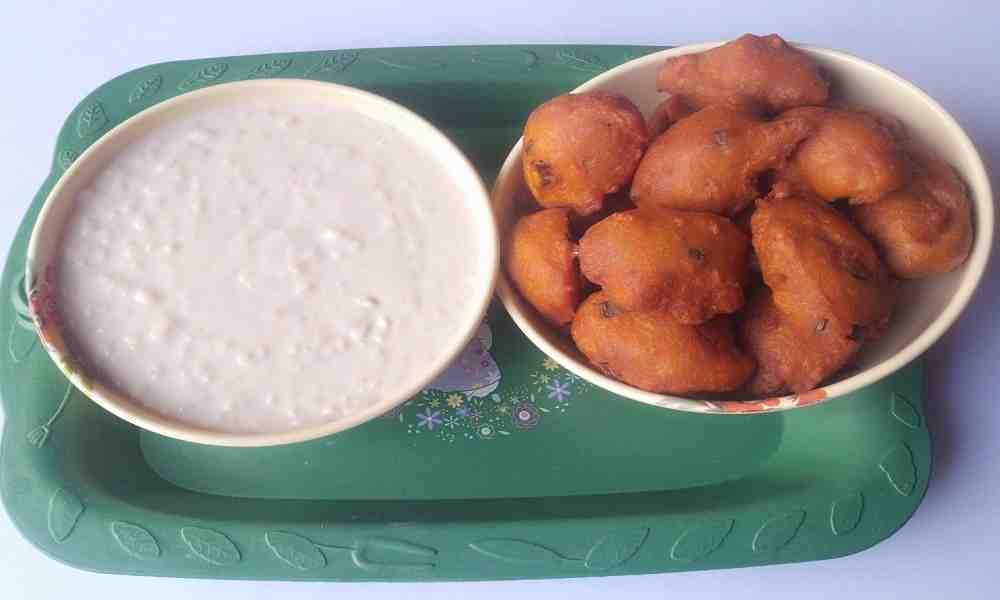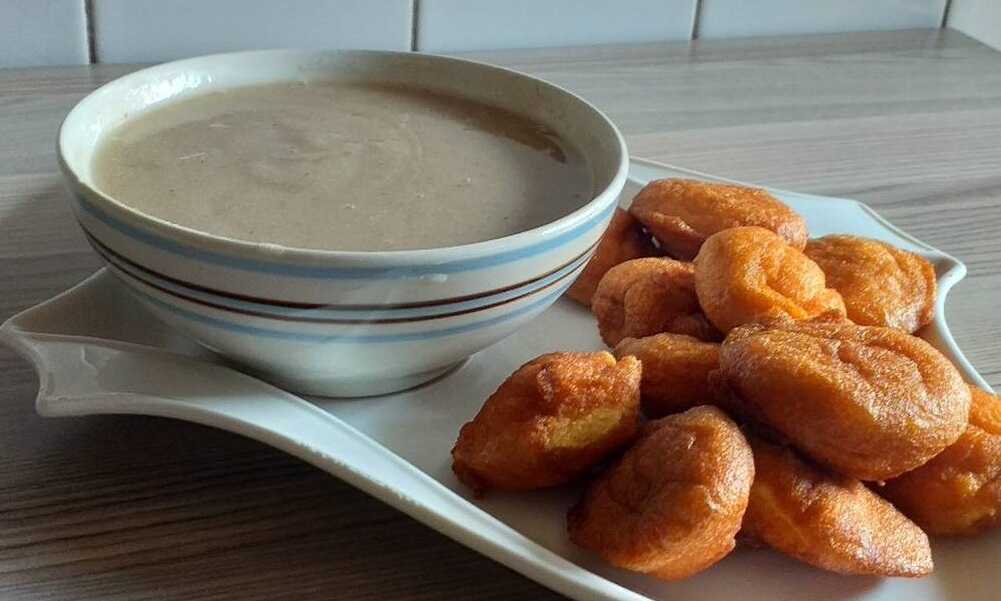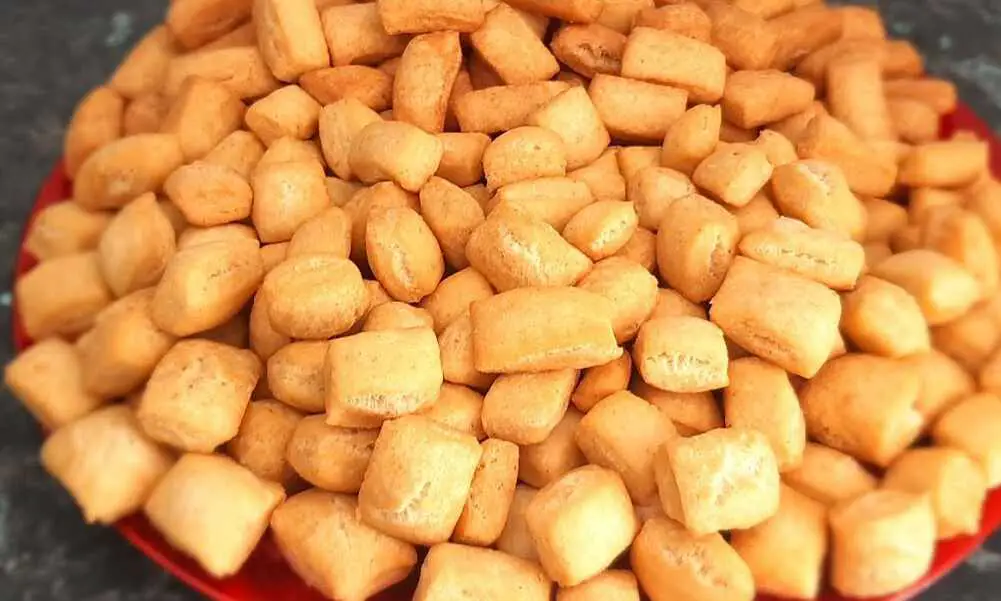
by Abu Hafsah | Jan 23, 2022 | Local Delicacies
As the name implies in Hausa, Kunun Gyada is derived from Kunu (meaning pap) and Gyada (meaning groundnut); when you put the two words together, you will have Kunu Gyada, meaning Groundnut Pap. It is a pap that is very popular in northern Nigeria, most especially among the Fulanis, whom you cannot wait to add to your meals, especially breakfast, although Hausas are beginning to embrace the consumption of this recipe too.
There are two ways to prepare the Kunun Gyada: one with rice and one without. In this article, I will take you through the process of making the two. There are two major ingredients for preparing Kunun Gyada that need processing before usage: groundnut and guinea corn. It is paramount that you know how to go about processing the two. Let’s see how:
How to Process the Groundnut for Kunun Gyada
STEP 1: Get your groundnut (preferably the one with the red back because it contains less oil) and pick the dirt from it.
STEP 2: Over high heat, put a frying pan (the size of the frying pan should depend on the quantity of groundnut) and pour sharp sand (sandy soil) into it. Then;
STEP 3: When the sand gets very hot, pour in your groundnut and stir at regular intervals—say, 5 seconds of waiting time in between stirs. Roast for 20 minutes
STEP 4: When roasted, put the frying pan down and spread on a hard surface so as to cool faster.
STEP 5: Pick out the groundnut from the sandy soil. Then;
STEP 6: Peel the back of the groundnut.
STEP 7: If the groundnut isn’t much, you can use a blender by adding a little water to it and blending until it turns into a paste. However, if it is in large quantity, take it to a commercial grinding machine.
How to Process the Guinea Corn for Kunun Gyada
For the guinea corn, well, there are two ways you can have it: either in powdered form or in the form of a paste. For the one in paste form:
STEP 1: Pick the dirt from the guinea corn and wash it well.
STEP 2: Soak in water for 6 hours. You could do that overnight if you intend to make it in the morning.
STEP 3: By now, the grains are already soft. Good.
STEP 4: Wash the grain again and add ginger and kaninfari (cloves).
STEP 5: If it is in small quantity, you can use a blender. Blend it until it turns to paste. If it is a large quantity, I will advise you to take it to a commercial grinding machine.
For the powdered form:
STEP 1: Pick the dirt from the guinea corn and wash it well.
STEP 2: After washing, drain it well and spread it on a mat outside to dry. Then;
STEP 3: Add ginger and kaninfari (cloves) to it.
STEP 4: Use a blender to grind it if it is in small quantities. Resort to a commercial grinding machine if it is in large quantity.
STEP 5: Use a sieve to sieve it well.
Well, to save you all the stress, both the groundnut and guinea corn (paste or powered) have already been sold in the markets.
Having known all this, let’s get cooking!
How to Make Kunun Gyada (with Rice)
Ingredients
You will need the following ingredients to make Kunun Gyada with rice:
1 cup of roasted groundnut
Tamarind (tsamiya)
2 cups of powdered guinea corn, or the desired quantity if using the paste form.
Short-grain rice
Sugar
Procedure for Preparing Kunun Gyada (with Rice)
STEP 1: Soak the short-grain rice with hot water for 30 minutes and set aside.
STEP 2: Soak the tamarind (tsamiya) for 10 minutes with hot water and set aside. Then;
STEP 3: Get your powered guinea corn; pour water into it until it turns into something like a paste, but more watery. If you are using the one in paste, just add a little water and mix well. Set aside, too.
STEP 4: Get a clean bowl and pour in the roasted groundnut paste. Stir it gently, and it is properly mixed. Then add more water to it until it turns very watery for sieving ease.
NB: For the next 4 steps, ensure you have the exact quantity of Kunun Gyada that you want at the end of the day in the back of your mind, and consider that as you are ‘adding’.
STEP 5: Get a sieve and sieve it into a clean pot. You can repeat the sieving if you feel it is not smooth enough for you.
STEP 6: Put the pot over medium heat and add STEP 1 (soaked rice)
STEP 7: In the same pot, sieve STEP 2 (soaked tamarind). Then;
STEP 8: Allow the contents of the pot to boil. However, before it starts boiling, you need to be close to it to avoid spilling by stirring it regularly. Allow it to cook for 5 minutes.
STEP 9: Switch off the heat and allow it to cool for 5 minutes. This is very important, as it helps prevent lumps.
STEP 10: Now, get STEP 3 and add the content to the pot. Stir gently as you pour.
STEP 11: Tada! Your Kunun Gyada with rice is ready!
How to Make Kunun Gyada (without Rice)
Ingredients
Same with the ingredients used in making the one with rice except for the rice.
Procedure for Preparing Kunun Gyada (without Rice)
Repeat every step above, except that you will take out the steps that include rice.
How to Serve Kunun Gyada
This recipe can be served with Kosai, Fried Yam, Fried Sweet Potato, Fried Irish Potato, bread, Kuli-Kuli (Groundnut Cake), Moi Moi and various types of snacks.
Don’t forget to serve hot, but not too hot.
Occasions to Serve Kunun Gyada
For the core Fulanis, most especially those in Adamawa and Gombe, this recipe is a meal for any day, any time, and any event. As such, it can be served in naming ceremonies, wedding ceremonies, condolence waits, Eids, special occasions, breakfast, lunch, dinner, etc.
How to Store Kunun Gyada
This delicacy can be stored in a food flask or any warmer of your choice. However, to avoid hardening the surface of the Kunu in your warmer, sprinkle a little water on top of the Kunu before closing.
Kunun Gyada lasts for 24 hours in its best form. It is also important to know that it cannot be stored in a refrigerator.
Nutritional Value of Kunun Gyada
The nutritional value of Kunun Gyada cannot be overemphasized, as it is a good source of vitamins and minerals such as vitamin E, Magnesium, Folate, Copper, and Arginine. Again, the protein-rich composition of the groundnut in Kunun Gyada makes it great for people who are either trying to lose weight or trying to gain muscle strength. It also improves brain functioning, reduces cholesterol, and so much more.
You could also check out 8 weight loss exercises you can do at home.
Conclusion
Avoid taking this delicacy while it is very hot. You could hurt yourself because of the groundnut in it, which helps retain heat. Now that you know how to make Kunun Gyada, I believe you have another choice among the choices that you have to make for meals, most especially breakfast. Tell me in the comments section when you will be making this change.
If you find this article helpful, please leave a comment in the comments section below.
You are always welcome to visit Northpad Nigeria for more local Northern Nigerian delicacies.

by Fatima Sani | Jan 8, 2022 | Local Delicacies
Kunun Tsamiya recipe is a northern Nigerian delicacy that is mainly made from powdered millet and tamarind (tsamiya) – that is where the name even came from. It is a very common drink among the Hausas especially for nursing mothers as it is believed that it helps increase breast milk.
Without any delay, let’s get into how it is been prepared. Allow me to be your guide
Equipment for Making Kunun Tsamiya.
Sieve
Bowl
Cheesecloth
Cooking pot
Scoop
Ingredients
2 cups of powdered millet.
Tamarind in the quantity desired.
Spices (dried pepper, ginger, cloves.
Sugar
Water
Procedure for Preparing Kunun Tsamiya
STEP 1: Wash the millet and soak it for 6 hours. You could soak it overnight if you intend to make it in the morning.
STEP 2: By now, the millet grains are soft. Wash again with clean water and add your spices – dried pepper, ginger, and cloves.
STEP 3: Take it to grinders to grind it for you. After grinding, leave it to cool for 10 minutes.
STEP 4: Add more water to the ground millet to enable you to sieve it well and set it aside.
STEP 5: Over medium heat, place a clean pot and add water and tamarind into the pot. Allow it to boil. Alternatively, you could soak it for 30 minutes if you have enough time to spare.
STEP 6: Pour the powdered millet into a clean bowl and add some water. Stir it very well with a spoon of your choice.
STEP 7: When STEP 5 has reached boiling point, take it down and pour the boiling water into the mixed millet powder.
STEP 8: After that, start stirring it gently. But when it gets too thick for your liking, you can still add some water.
STEP 9: Add sugar to your taste to the Kunun Tsamiya and you are done!
As easy as that!
How to Serve Kunun Tsamiya
You can take Kunun Tsamiya recipe with Akara (Beans Cake), Kuli-Kuli (Groundnut Cake), Cincin, or any snack of your choice. It will interest you to know that you could just take this recipe alone without anything to go with it – it tastes just fine.
Occasions to Serve Kunun Tsamiya
To the best of my knowledge, there are no special occasions for the consumption of this pap recipe. This means that it can be consumed anywhere and anytime. Well, as I said earlier, it is advisable for breastfeeding mothers to take it as it is said to increase breast milk flow.
How to Store Kunun Tsamiya
Kunun Tsamiya recipe in its best quality does not last for more than 24 hours. In addition, it cannot be stored in a refrigerator. On that note, I suggested you make just enough for present consumption.
Nutritional Value of Kunun Tsamiya
Kunun Tsamiya’s health benefits cannot be overemphasized as it helps in heart health, diabetes management, and helps prevent asthmatic symptoms because of the millet in it.
Because of the Tamarind in it, it helps boost the immune system, improves digestion, improves blood circulation, aids weight loss, fights cancer and rapid aging among others.
Conclusion
As you have seen, this recipe is easy to make but for its taste, you will need to prepare it to feel it firsthand. So tell me, when do you intend to make it? For a change, try and make this for breakfast for yourself or your family.
If you find this article helpful, please leave a comment in the comments section below. Thank you.
You are always welcome to Northpad Nigeria for more local Northern Nigerian delicacies.

by Fatima Sani | Dec 18, 2021 | Local Delicacies
Cincin recipe otherwise spelled as ‘chin chin’ is a popular snack among Nigerians. It is consumed by almost all tribes and ethnic groups. They are common recipes for weddings, birthdays, festivals, etc. Its common ingredient is flour. In addition, it is a delicious snack, easy to make, and mostly loved by all children.
Do you have a wedding ceremony, eid, or festival and you find it difficult to come up with a snack to consume or use as a takeaway delicacy? Worry no more as I have come to your aid.
Equipment for making Cincin
Mixing bowl
Frying pan
Sieve
Scissors
Knife
Container
Ingredients
For the making of Cincin, you will need to follow the ingredients:
4 cups of flour.
1 cup of powdered milk
2 teaspoons of powdered vanilla flavor
Half a teaspoon of ground nutmeg
Small pinch of salt
3 eggs
Half a teaspoon of baking powder
Vegetable oil
1 butter
Water
Procedure for Making Cincin
STEP 1: The first thing to do is, crack the eggs in a small bowl and add a pinch of salt. Whisk together and set aside.
STEP 2: Put the sugar into a bowl, add the milk and mix.
STEP 3: In a clean bowl, sieve the flour, add baking powder and nutmeg to the bowl, and mix well. Then;
STEP 4: Add the butter to the flour and mix it very well too.
STEP 5: Add the mixture in STEP 2 and STEP 1 to the flour and mix it very well with your clean hands until a smooth dough is formed. Then;
STEP 6: Place the dough on a flat surface spread it with flour and start stretching the dough gently. However, ensure the dough isn’t too long or too thick.
STEP 7: When the dough is somewhat flat enough, use a knife and cut it into desired shapes and sizes. You could also use a scissor to do the cutting. Here, you will hold the dough with one hand and use the scissors to cut it with the other hand. For me, it is quite faster than using a knife.
STEP 8: Place a clean frying pan on medium heat, add your vegetable oil into the pan, and slice some onions into it too. Allow to fry for 3 minutes.
STEP 9: Add the cincin pieces to the hot oil and fry until it turns golden brown. Then;
STEP 10: Use a spoon to get out the fried cincin into a sieve container and allow them to cool.
STEP 11: Aaaaand your cincin is ready!
How to Serve Cincin
Cincin is usually served on plates. They can be consumed alone or with drinks. These drinks could be Kunun Zaki, Kunun Aya, carbonated drinks (though not good for your health), or other local drinks that we have.
Occasions to Serve Cincin
There are numerous occasions to best serve this delicacy or snack. It could be served in wedding ceremonies, during Sallah or Christmas periods, or during festive periods. Etc. In addition, it can be consumed anywhere, anytime.
Furthermore, they can be a part of the delicacies or snacks packed as souvenirs for guests during wedding ceremonies. In a Hausa family, Cincin is usually given to the bride among other snacks as she is taken to her husband’s house. This is to serve guests or visitors coming to wish the family well. Pretty much useful right?
How to Store Cincin
Cincin should be stored in a cool dry place. One good thing about its features or qualities is that it can last for several weeks without spoiling. Ensure to store it in the right container though.
Nutritional Value of Cincin
The Cincin recipe is majorly composed of carbs but also has moderate amounts of protein. Here are the nutrition facts for 3.5 ounces which is equivalent to 100 grams of whole-grain wheat flour: calories (340), water (11%), protein (13.2grams), sugar (0.4 grams) carbs (72 grams), fibre (10.7 grams), and fat (2.5 grams).
In addition, the consumption of Cincin has many health benefits which make it an interesting delicacy.
Conclusion
Conclusively, it is important to note that when you put too much egg in cincin recipe, it sucks up the vegetable oil, and too much vegetable oil in the human body is not healthy. However, additional eggs make it softer and not too crunchy.
If you find this article helpful, please leave a comment in the comments section below. Thank you.
You are always welcome to Northpad Nigeria for more local Northern Nigerian delicacies.



